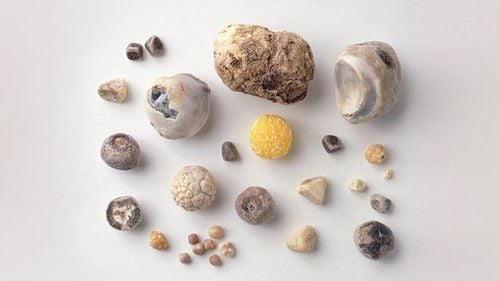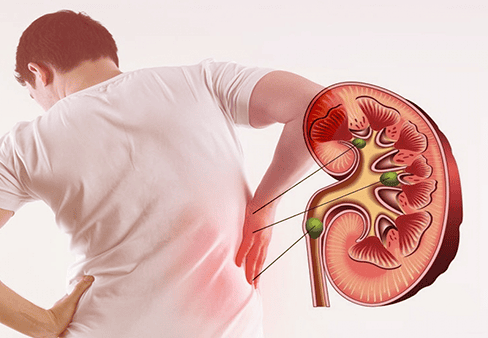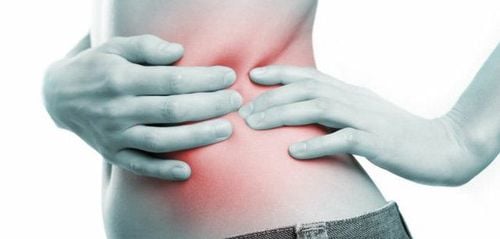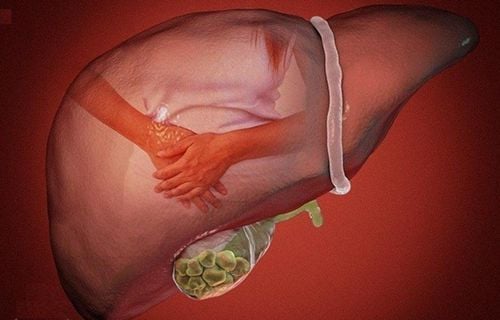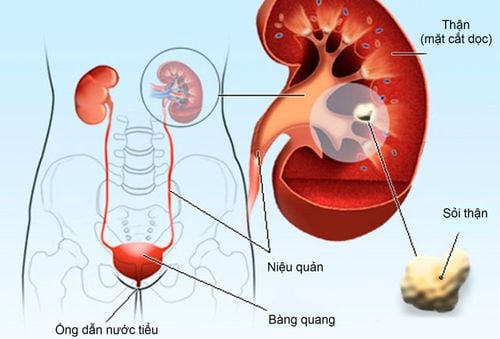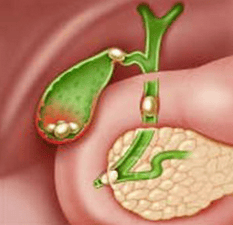This is an automatically translated article.
Currently, there are many methods of treating kidney stones that are applied. In particular, the method of kidney stone lithotripsy outside the body brings high treatment efficiency and less trauma to the patient.
1. Overview of kidney stone disease
Worldwide, urinary stones in general and kidney stones in particular are common diseases, accounting for 2 - 14% of the population. In Vietnam, the rate of patients with urolithiasis accounts for about 1-3% of the population and is the most common disease in urology.
Kidney stones are the process of accumulation of waste products in the body for a long time, forming solid crystals. Kidney stones come in many different sizes. The disease develops silently until there are obvious symptoms such as: pain in the abdomen between the ribs and hips, pain in the hips or middle of the back, pain radiating to the lower abdomen, accompanied by nausea or vomiting. , painful urination, foul-smelling or bloody urine, partial or complete urinary obstruction, possible urinary stones, high fever, chills, hematuria, pyuria,... If left untreated, stones will fall down the ureter or grow locally, causing kidney damage.
Kidney stone disease seriously affects the health and quality of life of patients. However, this is a disease that is easily acquired due to unscientific eating habits (eating a lot of salt, drinking less water) and has a high risk in people with digestive diseases, gout, people with sugar infections. urology for a long time, special jobs (pilots, policemen, athletes, drivers,...) and people who have a habit of eating dry.
Previously, open surgery was the first choice when treating kidney stones. However, today, with the development of technology, other less invasive intervention methods such as extracorporeal lithotripsy have become the more optimal choice for patients.

Bệnh sỏi thận gây ra các cơn đau
2. What is extracorporeal lithotripsy?
There are many methods of treating kidney stones, but extracorporeal lithotripsy is still the most advanced, modern and effective solution. This method uses an extracorporeal lithotripsy, which works on the principle of using focused shock waves to focus on the stone with a great pressure, causing the stone to break up by two mechanisms of compression and traction. After that, the stone fragments are discharged from the ureter, into the bladder, and out in the urine for about 7 - 15 days.
There are 4 different shock generator systems used for extracorporeal lithotripsy, including: Electromagnetic system, electro-hydraulic system, piezoelectric ceramic wave and explosive wave.
3. Advantages of extracorporeal lithotripsy
Gentle, painless, fast treatment (only about 1 hour), quick recovery; Does not cause damage to nearby internal organs in the body; Patients do not have to stay in the hospital, shortening treatment time and costs; Not performing open surgery should limit postoperative complications; Overcoming the phenomenon of remaining stones; Less damage to the kidneys because the effect of extracorporeal lithotripsy on kidney function is less than 1%. Meanwhile, if using open surgery to remove stones, it is possible to lose more than 30% of kidney function due to incisions on renal parenchyma.

Tán sỏi ngoài cơ thể người bệnh không phải nằm viện
4. Indications/contraindications for extracorporeal lithotripsy
4.1 Indications If kidney function is good and stone size is less than 2cm, percutaneous lithotripsy can be performed. When appointing treatment for extracorporeal kidney stone lithotripsy, it is necessary to base on the following criteria:
Stone size: Extracorporeal lithotripsy is the best treatment for cases with stones less than 20mm in size. Cases with larger stones need to be considered on a case-by-case basis, such as the level of contrast, the location of the stones in the kidney, the number of stones, the surface area of the stones,... In these cases, need to be combined with percutaneous kidney stone removal to increase the effectiveness of stone treatment; Location of stones: Renal pyelonephritis is the most fragile; The upper part of the ureter has a more fragile urine than the lower part. The kidney stones in the upper and middle calyx have a success rate of 75 - 80%, the lower calyx stones have a success rate of 60% because it is more difficult to eliminate through the renal pelvis; Chemical composition of stones: Stones that are too solid or too soft are difficult to disperse because they are difficult to break or if they are broken they stick together and cannot be eliminated. Struvite stones are fragile but easy to cause urinary tract infections, stone fragments are difficult to eliminate and easy to cause recurrence. In patients with kidney stones that are difficult to dissolve (brushite, cystine, calcium oxalate, monohydrate), extracorporeal lithotripsy should only be used for small stones and if two failed attempts at lithotripsy then should choose another treatment method; Number of stones: The stone should be dissolved when there are 1-2 tablets. If the number of stones is too much, not concentrated, it will be very difficult to disperse the stones, having to disperse many times; Asymptomatic stones: Patients with kidney stones have no symptoms, are working in special occupations that do not allow to stop working halfway; Lithotripsy after a number of treatment methods: Residual stones, recurrent stones after surgery, fragments of stones left after percutaneous kidney stone removal, ...
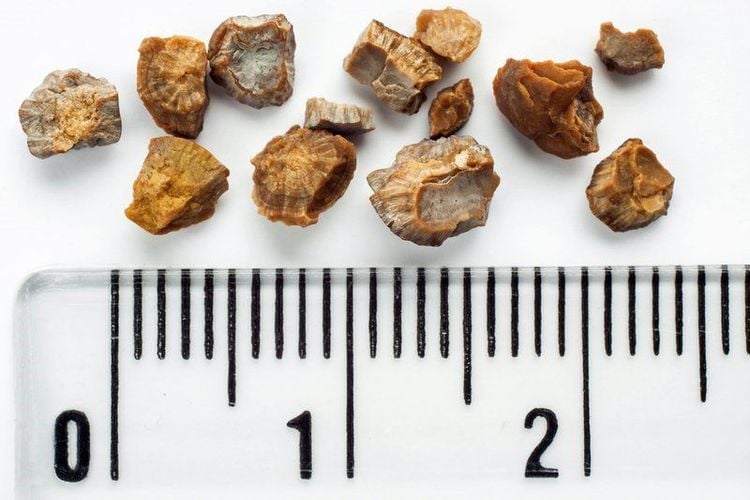
Hình ảnh sỏi thận
4.2 Contraindications Contraindicated to perform extracorporeal renal lithotripsy in the following patients:
Pregnant women: Because extracorporeal shock wave lithotripsy can affect the fetus; Bleeding disorders: Extracorporeal lithotripsy can lead to acute subcapsular and intrarenal hematomas or persistent hematuria, renal colic due to blood clots. In this case, it is recommended to treat kidney stones by ureteroscopy with laser lithotripsy; Aneurysms of the abdominal aorta or renal artery; For patients taking platelet-aggregating drugs: It is necessary to stop using aspirin before carrying out extracorporeal lithotripsy for a period of time depending on the dose of drug used by the patient; For patients with urinary tract infections: Need to be fully controlled before extracorporeal lithotripsy; Be careful with some other factors: Height, body weight (not suitable for the size of extracorporeal lithotripsy), anatomical abnormalities (spinal bifurcation or curvature, kyphosis ), Patients with shortness of breath due to pulmonary or cardiovascular disease, obstruction of stone ejection tract, very hard stones, etc.
5. The process of performing kidney stone lithotripsy outside the body
The patient is correctly diagnosed with the condition and location of the kidney stones; The patient lies on the table of the lithotripsy; The doctor pre-anesthetizes lightly, using the navigation system to locate the stone; The doctor directs the shock wave to focus on the stone, emitting pulses to disperse the stone; The energy generated from the machine's shock wave will focus on the pebble, breaking it up. On average, each course of treatment uses no more than 3,000 shock waves to break up stones while ensuring safety for the renal parenchyma. The time for a lithotripsy usually lasts about 1 hour. After lithotripsy, the patient can go home, no need to stay in the hospital.
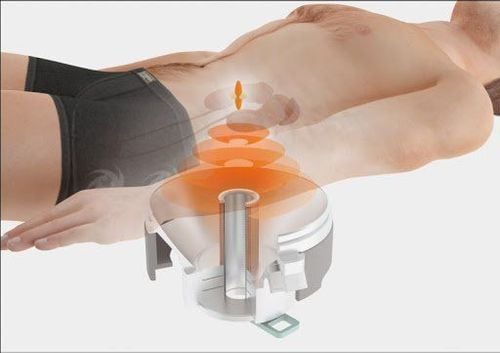
Tán sỏi thận ngoài cơ thể dùng sóng xung kích
6. Notes after extracorporeal lithotripsy
Patients may experience mild back pain and transient hematuria, which usually does not require medication; Patients should drink 2-3 liters of water/day to enhance the elimination of stone fragments through urine; If there are unusual complications, you should seek medical attention immediately; Regular check-ups as prescribed by your doctor. To prevent kidney stones from recurring, patients should note:
Reduce the amount of foods high in calcium and oxalates such as tea, chocolate, strawberries, almonds, animal protein,...; Every day should drink 1.5 - 2 liters of water, increase the use of black bean water, tapioca water, fruit juice with cool properties, diuretic and calcium excretion; Do not eat a lot of pig intestines, animal brains,...; Take certain medications to help control the amount of minerals in your urine. Detecting kidney stones when the stones are small, combined with extracorporeal lithotripsy is a strategy in disease treatment to bring about high economic and health benefits. In addition, because of the complexity of stones, it is also possible to apply some other methods of treating kidney stones such as percutaneous lithotripsy, ureteroscopy, conventional surgery,...
MORE:
Information for patients with extracorporeal lithotripsy What is extracorporeal lithotripsy? Methods of kidney stone - urology




